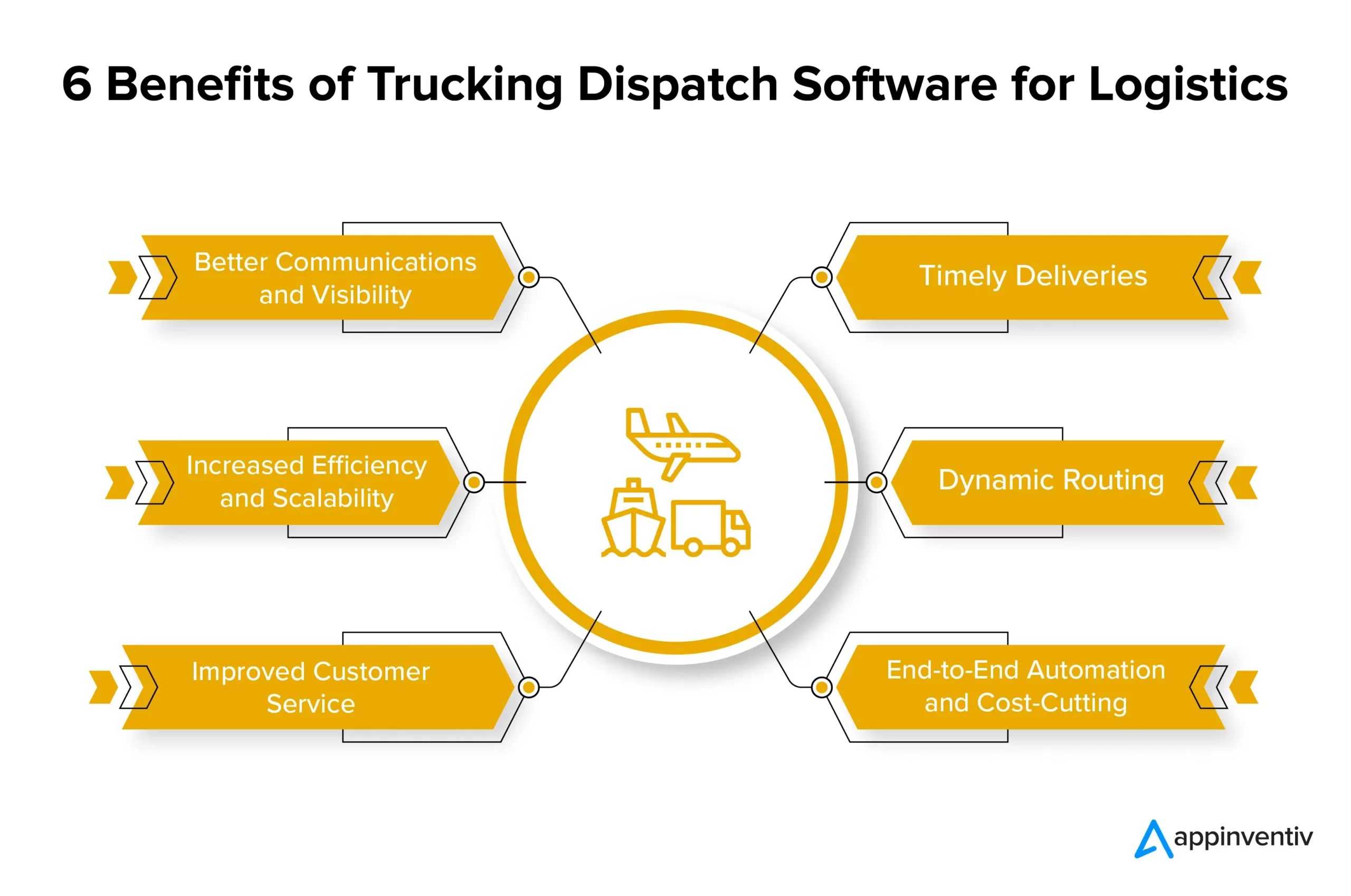Setting up performance metrics for trucking dispatch software is essential to monitor and optimize fleet operations effectively. By tracking key performance indicators (KPIs) such as shipping time, order accuracy, and equipment utilization rate, companies can gain valuable insights into their efficiency and make data-driven decisions.
This article will discuss the importance of performance metrics in the trucking industry and provide guidelines on how to develop effective metrics for dispatch software. Whether you are a small trucking company or a large fleet, understanding and utilizing performance metrics can help improve operations, reduce costs, and enhance customer satisfaction.
The Importance Of Performance Metrics For Trucking Dispatch Software
Setting up performance metrics for trucking dispatch software is crucial for the success of any trucking company. Performance metrics provide valuable data and insights that help companies monitor and improve their dispatching operations. In this article, we will explore the importance of performance metrics for trucking dispatch software and discuss the role they play in optimizing trucking operations.
Understanding The Role Of Performance Metrics In Trucking Dispatch
Performance metrics play a vital role in trucking dispatch as they provide quantifiable measurements of key aspects of the dispatching process. These metrics offer valuable insights into the efficiency, effectiveness, and overall performance of a company’s dispatching operations. They help trucking companies identify bottlenecks, measure performance against set benchmarks, and make data-driven decisions to improve their dispatching processes.
When it comes to trucking dispatch software, performance metrics can be used to track various aspects of the dispatching process, such as:
- Delivery time
- Order accuracy
- Pick and pack cycle time
- Equipment utilization rate
- Trailer utilization rate
By tracking these metrics, trucking companies can identify areas where they can improve efficiency and reduce costs. For example, if the delivery time metric consistently falls below the set benchmark, it may indicate issues with route optimization or driver scheduling. By analyzing these metrics, companies can make data-driven decisions to address these issues, optimize their dispatching operations, and ultimately enhance customer satisfaction.
Benefits Of Using Performance Metrics In Trucking Dispatch
Using performance metrics in trucking dispatch offers numerous benefits for trucking companies. These benefits include:
- Improved Efficiency: Performance metrics enable companies to identify inefficiencies and bottlenecks in their dispatching operations. By addressing these issues, companies can streamline their processes, reduce costs, and improve overall efficiency.
- Enhanced Decision-Making: Performance metrics provide data-driven insights that empower companies to make informed decisions. By analyzing performance metrics, companies can identify trends, track progress, and make adjustments to optimize their dispatching processes.
- Increased Customer Satisfaction: By monitoring performance metrics such as delivery time and order accuracy, trucking companies can ensure timely and accurate deliveries, leading to improved customer satisfaction. Satisfied customers are more likely to become repeat customers and recommend the company to others.
- Optimized Resource Allocation: Performance metrics help companies identify underutilized or overutilized resources, such as trucks and trailers. By analyzing these metrics, companies can optimize resource allocation, reduce idle time, and maximize productivity.
In conclusion, performance metrics are essential for trucking dispatch software as they provide valuable insights into the efficiency and effectiveness of dispatching operations. By tracking and analyzing these metrics, trucking companies can optimize their processes, reduce costs, and enhance customer satisfaction. Implementing performance metrics in trucking dispatch software is a strategic move that can lead to improved operational performance and increased competitiveness in the trucking industry.

Credit: www.docshipper.com
Key Performance Indicators (kpis) For Trucking Dispatch Software
In the trucking industry, setting up performance metrics is crucial for measuring the effectiveness and efficiency of dispatch operations. Key Performance Indicators (KPIs) play a vital role in evaluating the performance of trucking dispatch software. They provide valuable insights into various aspects of logistics and help identify areas for improvement. In this article, we will dive into understanding KPIs in the trucking industry, essential KPIs for tracking logistics performance, and common KPIs for trucking dispatch software.
Understanding Kpis In The Trucking Industry
KPIs in the trucking industry are measurable values that reflect the performance and success of various operations. These metrics help trucking companies analyze critical factors such as on-time delivery, order accuracy, asset utilization, and driver productivity. By tracking and analyzing these KPIs, businesses can make data-driven decisions to optimize their logistics operations.
Essential Kpis For Tracking Logistics Performance
When it comes to tracking logistics performance, there are several essential KPIs that trucking companies should monitor:
- Shipping Time: Measures the time taken from order dispatch to delivery.
- Order Accuracy: Evaluates the accuracy of order fulfillment.
- Picking Accuracy: Measures the accuracy of item picking in warehouses.
- Delivery Time: Tracks the time taken for deliveries to reach their destinations.
- Pick & Pack Cycle Time: Calculates the time required for order picking and packaging.
- Order Cycle Time: Analyzes the time taken from order placement to delivery completion.
- Equipment Utilization Rate: Measures the efficient use of trucks and other transportation equipment.
- Trailer Utilization Rate: Evaluates the utilization of trailers for shipping and transport.
Common Kpis For Trucking Dispatch Software
In addition to the essential logistics KPIs mentioned above, there are specific KPIs that trucking dispatch software focuses on to measure performance:
| KPI | Description |
|---|---|
| On-Time Delivery Percentage | Measures the percentage of orders delivered on time. |
| Load Profitability | Evaluates the profitability of each load or shipment. |
| Driver Utilization Rate | Tracks the utilization of drivers and their productivity levels. |
| Dispatch Efficiency | Measures how efficiently the dispatching process is managed. |
By monitoring and analyzing these common KPIs, trucking companies can optimize their dispatch operations, improve profitability, and enhance customer satisfaction.
Setting Up Performance Metrics For Trucking Dispatch Software
Tracking and measuring performance metrics is crucial for optimizing trucking dispatch operations. By setting up clear and measurable targets, implementing efficient systems, and analyzing performance data, companies can drive improvements and enhance their overall efficiency. In this article, we will guide you through the process of setting up performance metrics for your trucking dispatch software.
Identifying Relevant Metrics For Your Dispatch Operations
To start, it is essential to identify the most relevant metrics for your specific dispatch operations. These metrics will allow you to gauge your performance and identify areas for improvement. Some key metrics to consider include:
- On-time delivery percentage
- Driver utilization rate
- Fuel efficiency
- Load capacity utilization
- Customer satisfaction ratings
Defining Clear And Measurable Targets For Each Metric
Once you have identified the relevant metrics, it is important to define clear and measurable targets for each metric. This will provide you with a benchmark to assess your performance against. For example, you may set a target to achieve a minimum of 95% on-time delivery percentage or a driver utilization rate of at least 90%. By defining these targets, you can easily track your progress and identify any areas that need improvement.
Implementing Systems To Track And Monitor Performance Metrics
Implementing systems to track and monitor your performance metrics is vital for efficient dispatch operations. This can be done through the use of trucking dispatch software that offers performance reporting and analytics features. Such software allows you to collect and analyze data in real-time, enabling you to make informed decisions and quickly respond to any issues that arise. Additionally, it provides a centralized platform for storing and accessing performance data.
Analyzing And Utilizing Performance Data To Drive Improvements
Regularly analyzing and utilizing performance data is the key to driving improvements in your trucking dispatch operations. By reviewing the data, you can identify trends, areas of inefficiency, and potential bottlenecks. This enables you to implement targeted solutions and optimize your processes. Through data-driven decision-making, you can make strategic changes that will positively impact the overall performance of your dispatch operations and ultimately lead to increased customer satisfaction and profitability.
Best Practices For Optimizing Trucking Dispatch Performance
Optimizing trucking dispatch performance involves setting up performance metrics for trucking dispatch software. These metrics track important aspects such as shipping time, order accuracy, and equipment utilization rate, allowing companies to compare their performance and achieve efficient delivery management.
Setting up performance metrics for trucking dispatch software is essential for optimizing efficiency and productivity in the transportation industry. By establishing clear metrics and following best practices, dispatch teams can streamline operations, improve communication, and enhance fleet performance. In this section, we will explore several key areas where best practices can significantly impact trucking dispatch performance.Improving Route Planning And Optimization
One of the most critical factors in trucking dispatch performance is efficient route planning and optimization. By using advanced dispatch software, dispatch teams can analyze various factors such as traffic conditions, delivery deadlines, and fuel efficiency to create optimized routes for drivers. This helps reduce fuel costs, minimize delivery time, and improve customer satisfaction. Additionally, implementing real-time GPS tracking can further enhance route optimization by providing real-time updates on driver locations, enabling dispatchers to make necessary adjustments to routes on the go.Enhancing Communication And Collaboration
Effective communication and collaboration are vital for smooth trucking dispatch operations. Dispatch software can facilitate communication between dispatchers, drivers, and customers through various channels such as email, SMS, and in-app messaging. By enabling instant communication, dispatch teams can quickly address any issues or changes that may arise during the delivery process, ensuring timely and accurate deliveries. Furthermore, implementing collaboration features such as shared calendars and task lists can help streamline workflow and ensure everyone is on the same page.Streamlining Workflow And Task Management
Streamlining workflow and task management is crucial for optimizing trucking dispatch performance. Dispatch software can automate repetitive tasks such as data entry, route assignment, and documentation, reducing the administrative burden on dispatchers. By automating these processes, dispatch teams can save time and focus on more critical tasks, such as monitoring driver performance and handling exceptions. Additionally, implementing a centralized dashboard that provides real-time visibility into pending tasks, driver availability, and delivery statuses can help dispatchers prioritize and efficiently manage their workload.Monitoring And Managing Fleet Performance
Monitoring and managing fleet performance is essential for optimizing trucking dispatch operations. By tracking key performance indicators (KPIs) such as on-time delivery rate, fuel efficiency, and driver performance, dispatch teams can identify areas for improvement and take proactive measures to enhance fleet performance. Dispatch software can provide real-time insights and generate performance reports, enabling dispatchers to make data-driven decisions and implement strategies to optimize fleet operations. Regularly monitoring and analyzing KPIs can help identify trends, evaluate the effectiveness of new initiatives, and drive continuous improvement.Continuous Training And Development Of Dispatch Team
Investing in the continuous training and development of the dispatch team is crucial for optimizing trucking dispatch performance. By providing ongoing training on dispatch software features, industry best practices, and emerging technologies, dispatch teams can stay updated with the latest trends and techniques. Regular training sessions can help improve dispatchers’ skills, enhance their ability to handle complex situations, and ensure they are equipped to maximize the potential of the dispatch software. Moreover, encouraging a culture of continuous learning and knowledge sharing within the dispatch team fosters innovation and drives overall performance improvement. In conclusion, implementing best practices in route planning and optimization, communication and collaboration, workflow and task management, fleet performance monitoring, and continuous training and development can significantly optimize trucking dispatch performance. By leveraging the capabilities of advanced dispatch software and adopting these best practices, dispatch teams can enhance efficiency, reduce costs, and improve customer satisfaction in the trucking industry.Tools And Software For Tracking And Analyzing Performance Metrics
When it comes to running a successful trucking dispatch operation, tracking and analyzing performance metrics is crucial. This allows you to evaluate the efficiency of your processes, identify areas for improvement, and make data-driven decisions to optimize your operations. With the right tools and software for tracking and analyzing performance metrics, you can gain valuable insights into your dispatch operations and drive your business towards success.
Overview Of Dispatch Software With Performance Metrics
Dispatch software with performance metrics is designed to help trucking companies monitor and measure the key performance indicators (KPIs) that are essential for tracking the effectiveness of their dispatch operations. These software solutions provide a centralized platform where dispatchers can view real-time data and generate reports on various metrics, such as delivery time, order accuracy, equipment utilization rate, and more. By having access to this information, dispatchers can identify patterns, trends, and potential bottlenecks, allowing them to proactively address issues and improve overall performance.
Benefits Of Using Performance Tracking Software
Implementing performance tracking software for trucking dispatch offers several benefits for your business. Let’s take a look at some of the advantages:
- Improved Efficiency: Performance tracking software helps you streamline your dispatch operations by providing real-time visibility into driver location, job status, and delivery schedules. This allows you to make more informed decisions, assign jobs efficiently, and optimize routes to minimize time and fuel wastage.
- Enhanced Customer Service: With performance tracking software, you can provide accurate and up-to-date information to your customers regarding their shipments. This improves transparency and customer satisfaction by reducing delays, enabling timely notifications, and ensuring efficient communication within the entire supply chain.
- Data-Driven Decision Making: Analyzing performance metrics helps you identify areas of improvement, identify potential cost-saving opportunities, and implement proactive measures to enhance operational efficiency. It enables you to base your decisions on solid data rather than guesswork, leading to better outcomes and higher profitability.
- Compliance and Safety: Performance tracking software allows you to monitor driver behavior, adherence to regulations, and compliance with safety protocols. By tracking metrics related to safety and compliance, you can ensure that your fleet operates within legal boundaries, minimizing risks and avoiding costly penalties.
Popular Performance Tracking Tools For Trucking Dispatch
There are several performance tracking tools available specifically tailored for trucking dispatch operations. Here are a few popular options:
| Tool | Description |
|---|---|
| DispatchTrack | A comprehensive, cloud-based truck dispatch software that provides a suite of performance metrics, including delivery time, on-time performance, driver utilization, and more. |
| PCS | A versatile truck dispatch software solution that offers performance tracking features such as asset management, cost tracking, accounting integration, and compliance monitoring. |
| Onfleet | A delivery management software that allows you to track live driver locations, optimize routing, monitor driver performance, and analyze key metrics to improve overall dispatch efficiency. |
These are just a few examples of the many tools available. It’s important to research and choose a performance tracking tool that aligns with your specific business needs and goals.

Credit: www.truckingoffice.com

Credit: www.matellio.com
Frequently Asked Questions On Setting Up Performance Metrics For Trucking Dispatch Software
What Is Kpi In Dispatch?
KPI in dispatch refers to Key Performance Indicators used to measure the efficiency and effectiveness of trucking dispatch operations. These metrics help track important aspects such as shipping time, order accuracy, delivery time, and equipment utilization rate. By monitoring these KPIs, businesses can improve their performance and optimize their logistics processes.
How Do You Come Up With Performance Metrics?
To come up with performance metrics, first identify the key aspects you want to measure. Then, determine the specific metrics that align with those aspects, such as shipping time, order accuracy, and equipment utilization rate. Finally, establish a tracking system to regularly monitor and analyze the data for insights and improvement.
How Do You Measure Logistics Performance?
To measure logistics performance, track important KPIs and metrics such as shipping time, order accuracy, picking accuracy, delivery time, pick & pack cycle time, order cycle time, equipment utilization rate, and trailer utilization rate. These metrics provide valuable insights into the efficiency and effectiveness of your logistics operations.
What Is Kpi In Trucking Industry?
KPI in the trucking industry refers to Key Performance Indicators, which are important metrics used to measure the performance and efficiency of trucking operations. These metrics can include factors such as shipping time, order accuracy, delivery time, and equipment utilization rate.
By tracking these KPIs, trucking companies can assess their performance and make informed decisions to improve their operations.
Conclusion
Setting up performance metrics for trucking dispatch software is crucial for measuring and improving the efficiency and effectiveness of your fleet operations. By tracking key performance indicators (KPIs) such as shipping time, order accuracy, delivery time, and equipment utilization rate, you can gain valuable insights into your logistics performance and make data-driven decisions.
With the right trucking dispatch software, like DispatchTrack or Truckbase, you can easily monitor these metrics and optimize your operations for better results. Remember, consistently measuring and analyzing performance metrics is the key to success in the trucking industry. So, start implementing these metrics today and take your fleet management to new heights.



